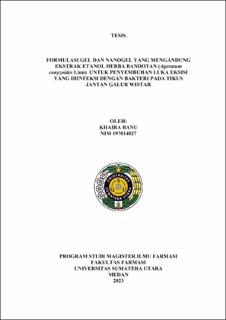Formulasi Gel dan Nanogel yang Mengandung Ekstrak Etanol Herba Bandotan (Ageratum Conyzoides Linn) Untuk Penyembuhan Luka Eksisi yang Diinfeksi dengan Bakteri pada Tikus Jantan Galur Wistar
Formulation of Gel and Nanogel Extract Ethanol Herba Bandotan (Ageratum Conyzoides Linn) and Activity Infection Wound Healing On Rats

Date
2023Author
Banu, Khaira
Advisor(s)
Arianto, Anayanti
Harahap, Urip
Metadata
Show full item recordAbstract
The bacteria Staphylococcus aureus, Staphylococcus epidermidis, and Pseudomonas aeruginosa are natural skin flora that can cause infection and tissue damage in open wound conditions. The plant Bandotan has been utilized in traditional medicine for wound healing purposes. Chemical compounds such as alkaloids, flavonoids, and terpenoids have been extracted from the Bandotan plant. Based on previous research, it has been found that a gel formulation containing 7.5% concentration of Ageratum conyzoides Linn extract exhibits wound healing effects. In this study, the extract of bandotan is made in a nanogel that has advantages in the drug delivery system such as effectiveness, controllability, consistency, and stable dosage capacity due to the presence of internal silang tautan in the structure. This research aims to produce an extract of ethanol from bandotan herb in the form of a nanogel, test its antibacterial activity, and investigate activity of wound healing in rats. The ethanol extract of bandotan herb was obtained through maceration using a 96% ethanol solvent. Subsequently, the antibacterial activity against Staphylococcus aureus, Staphylococcus epidermidis, and Pseudomonas aeruginosa was tested. The extract then formulated into three nanogel and gel formulas, namely F1 (5%), F2 (7.5%), and F3 (10%). These formulas were further evaluated for their antibacterial activity, formulation characteristics, stability, and wound healing properties in rats. The rats are divided into 11 groups, namely the normal group, infected group, positive control group, negative control group (gel-based and nanogel-based), 3 gel formulas, and 3 nanogel formula. The rats were subjected to injury and infected with selected bacteria, resulting in the observation of pus formation, redness, and wound diameter enlargement. Subsequently, gel and nanogel preparations were administered for a duration of 15 days. The healing effects of the wounds were then macroscopically evaluated by measuring the wound diameter and subjected to statistical analysis. Microscopic analysis was conducted on days 8 and 15, specifically examining the epidermal thickness and collagen density.
The ethanol extract of the bandotan herb contains chemical compounds such as alkaloids, flavonoids, glycosides, saponins, tannins, and triterpenoids. The produced gel and nanogel formulations exhibit a viscous consistency, green color, homogeneous nature, and stability. The results of the antibacterial test on gel and nanogel formulations of ethanol extract from Bandotan herb demonstrate a stronger efficacy against Staphylococcus aureus bacteria, so warranting its selection as the bacterium for wound healing experimentation. The group of rats treated with Bioplacenton (Control +) followed by nanogel at concentrations of 10%, 7.5%, and gel at 10% exhibited the highest percentage reduction in wound diameter after 15 days. Conversely, the groups treated with gel at 7.5%, 5%, negative control, normal wound, and infected wound showed smaller percentage reductions in wound diameter. Under microscopic examination, the group treated with Bioplacenton (Control +) and nanogel exhibited a thicker and denser epidermal layer compared to the gel formulation, and the statistical analysis revealed a significant difference (P < 0.05).
Based on the findings of this study, it can be concluded that the nanogel formulation of ethanol extract from bandotan herb exhibits green color, little viscosity, and stability during a 12-week storage period at room temperature, both at low and high temperatures. The results of macroscopic and microscopic observations on the healing effects of excision wounds in rats indicate that the nanogel formulation of ethanol extract from the bandotan herb is more effective compared to its gel formulation.
Collections
- Magister Theses [371]
